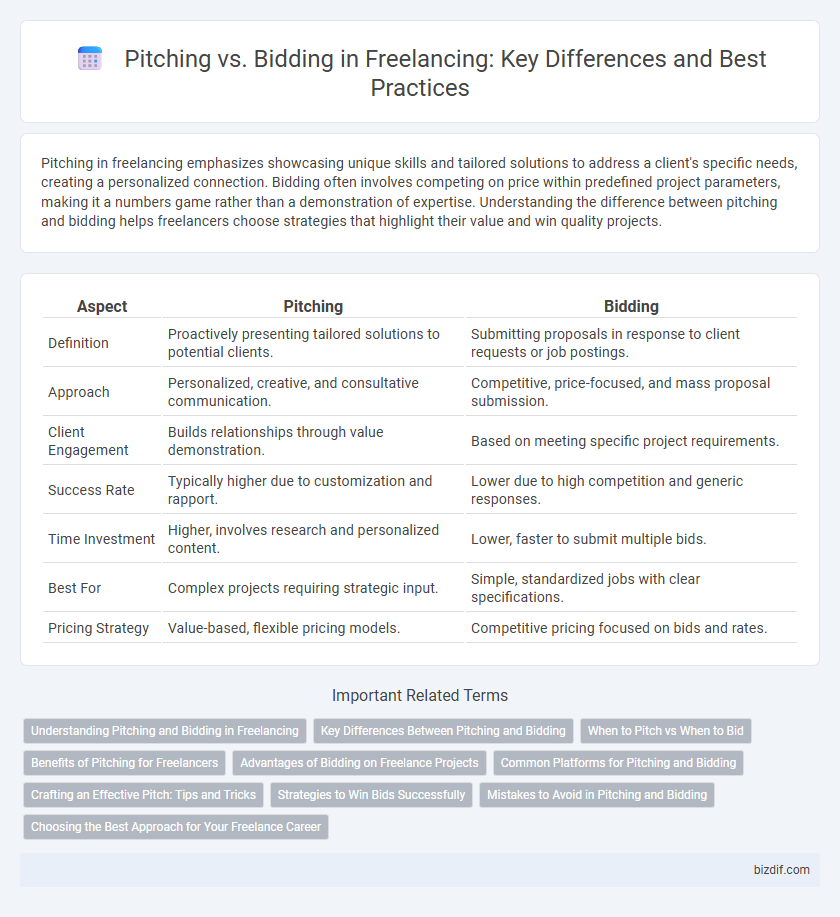Pitching in freelancing emphasizes showcasing unique skills and tailored solutions to address a client's specific needs, creating a personalized connection. Bidding often involves competing on price within predefined project parameters, making it a numbers game rather than a demonstration of expertise. Understanding the difference between pitching and bidding helps freelancers choose strategies that highlight their value and win quality projects.
Table of Comparison
| Aspect | Pitching | Bidding |
|---|---|---|
| Definition | Proactively presenting tailored solutions to potential clients. | Submitting proposals in response to client requests or job postings. |
| Approach | Personalized, creative, and consultative communication. | Competitive, price-focused, and mass proposal submission. |
| Client Engagement | Builds relationships through value demonstration. | Based on meeting specific project requirements. |
| Success Rate | Typically higher due to customization and rapport. | Lower due to high competition and generic responses. |
| Time Investment | Higher, involves research and personalized content. | Lower, faster to submit multiple bids. |
| Best For | Complex projects requiring strategic input. | Simple, standardized jobs with clear specifications. |
| Pricing Strategy | Value-based, flexible pricing models. | Competitive pricing focused on bids and rates. |
Understanding Pitching and Bidding in Freelancing
Pitching in freelancing involves presenting personalized proposals that highlight unique skills and solutions tailored to a client's specific project needs, enhancing the freelancer's chances of capturing interest. Bidding consists of submitting competitive offers based primarily on price and project scope, often through centralized platforms where freelancers compete for visibility. Understanding the nuances between pitching and bidding is crucial for freelancers to effectively position themselves and secure high-quality contracts.
Key Differences Between Pitching and Bidding
Pitching involves presenting a tailored proposal highlighting unique value and creative solutions to win a project, while bidding focuses on submitting competitive, often price-driven offers based on predefined project requirements. Pitching emphasizes relationship-building and showcasing expertise, whereas bidding relies on meeting criteria and offering the best cost or timeline. Understanding these differences helps freelancers choose the right approach for client engagement and project acquisition.
When to Pitch vs When to Bid
Pitching is ideal when targeting high-value, customized projects that require demonstrating unique skills and personal connection, often suited for long-term collaborations. Bidding works best for well-defined, standardized tasks where price and quick turnaround are primary factors, commonly found in competitive marketplaces. Evaluating project complexity, client expectations, and engagement style helps determine the strategic choice between pitching and bidding in freelancing.
Benefits of Pitching for Freelancers
Pitching allows freelancers to showcase their unique skills and creativity, making it easier to stand out from competitors. By tailoring proposals to specific client needs, pitching increases the chances of winning projects and building lasting professional relationships. This proactive approach also helps freelancers position themselves as experts, often leading to higher rates and better project opportunities.
Advantages of Bidding on Freelance Projects
Bidding on freelance projects enables freelancers to set competitive prices that match their skill levels and market demand, increasing the likelihood of securing jobs. It provides clear expectations for both clients and freelancers regarding budget and deliverables, enhancing transparency. Moreover, bidding platforms often include feedback and rating systems that help freelancers build credibility and attract more clients over time.
Common Platforms for Pitching and Bidding
Freelancers often use platforms such as Upwork, Freelancer, and Fiverr to pitch or bid for projects, with Upwork being the most popular for both pitching and competitive bidding. On Fiverr, freelancers typically showcase predefined services, minimizing direct pitching, while Freelancer offers a blend of bidding and proposal pitching to clients. These platforms streamline project acquisition by connecting freelancers with clients through tailored pitching and bidding processes optimized for various industries.
Crafting an Effective Pitch: Tips and Tricks
Crafting an effective pitch requires clear communication of your unique value proposition and relevant experience to capture the client's attention quickly. Highlight specific skills and past project successes that directly align with the client's needs, demonstrating your capability to deliver results. Use concise language and include a compelling call to action to encourage further engagement and increase your chances of winning the freelance project.
Strategies to Win Bids Successfully
Crafting a compelling pitch requires clear articulation of unique skills and tailored solutions that align with client needs, setting freelancers apart from competitors. Effective bidding strategies involve thorough research on project requirements, competitive pricing, and timely submissions to increase chances of selection. Combining personalized communication with data-driven insights enhances credibility and builds trust, crucial factors for winning freelance projects consistently.
Mistakes to Avoid in Pitching and Bidding
Common mistakes to avoid in pitching and bidding for freelancing projects include submitting generic proposals that lack personalization and fail to address the client's specific needs. Overpricing or underpricing services without proper market research can lead to lost opportunities or undervaluing your skills. Neglecting clear communication, such as failing to outline deliverables, timelines, and payment terms, often results in misunderstandings and project delays.
Choosing the Best Approach for Your Freelance Career
Pitching allows freelancers to showcase their unique value by crafting tailored proposals that highlight specific skills and past successes, making it ideal for projects requiring creativity and personalized solutions. Bidding, on the other hand, emphasizes competitive pricing and quick responses, often benefiting freelancers in highly commoditized markets or volume-driven platforms. Selecting the best approach depends on the freelancer's niche, project complexity, and ability to differentiate themselves from competitors effectively.
Pitching vs Bidding Infographic

 bizdif.com
bizdif.com